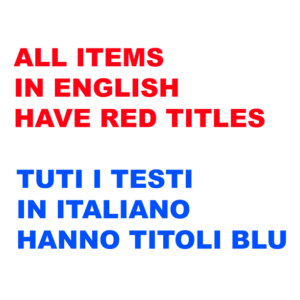Thinking unpleasant thoughts
—————-
By Beppe Colli
March 17, 2006
There are things that one already knows. But hearing about them again
– as for the first time, so to speak – won’t make one feel any better.
Case in point: the state of publishing – meaning: books – about music.
I just got a letter from a friend and colleague who lives and works
in the USA, and the picture he painted using facts and figures that
are known to him first-hand is certainly not terribly encouraging. Talking
about the specific case of books of a "technical" nature –
i.e., books that are mainly, though not exclusively, of interest to
people who are involved in music, whatever their task – the situation
today looks like this: those titles that are somewhat ambitious in wanting
to present a complete picture will sell a lot less than those which
deal with a single, tiny, topic explained in an easy way and whose aim
is exclusively of a practical nature. Using an expression that’s a bit
raw, but is obviously effective in conveying the intended meaning, my
friend wrote: "If you can’t read it while you’re taking a dump,
it won’t sell. Or something like that".
It
goes without saying that the trend in question has been apparent for
quite some time. Just consider the deep change of US mags such as Musician
and Keyboard. The technical reviews were always there, obviously; but
– after considering that investigating a brand-new technology (say,
FM synthesis or sampling) is a quite different thing than reviewing
a new plug-in – keep in mind that it’s the nature of interviews that
has changed: whereas the long conversations of yesterday – with Wendy
Carlos or Thomas Dolby, Wayne Horvitz or Laurie Anderson – saw the technical
element in a deep relationship with the creative process (a process
of which the technical element can be considered as one of the strongest
originators), the three meager pages of today quite often consist of
just a plain description of the software that was used.
Could
it be a consequence of the ever-increasing difficulties readers have
when it comes to the written language? Or maybe it’s a consequence of
the pressure coming from advertisers? Or maybe the real reason is a
narrowing of readers’ horizons? Or maybe the shrinking horizons are
those of people who make records today? I have to say that reading those
articles featured in the series called Classic Tracks which appears
(also on the Web, and for free) in the pages of UK mag Sound On Sound
is extremely useful, not to mention entertaining. Be it ’cause of good
verbal content, or good music, very often one has the impression that
one is reading about the building of a Gothic Cathedral – not of a modern
mall.
Meanwhile, sales of music on the
Net have taken off, first of all thanks to Apple’s iTunes format. First
consequence being decreasing CD sales. (But really: did anyone expect
a different outcome?) The "new problem of the day" looks like
this: a lot of people are mainly buying only some "chosen tracks"
(which are sold at 99 cents) instead of the whole CD of which they are
(at this point, only in theory) a part. The consequence: loss of revenues
– and profits – on the part of the record companies. The solution?
On the cover of issue # 994 (February
23, 2006) of the US edition of Rolling Stone, besides Mariah Carey showing
the miraculous properties of Photoshop, we have this title: Teens Save
Classic Rock – New Life For Hendrix, Floyd & Zeppelin. So one has
to go to page 11, where one finds an article by Brian Hiatt titled Classic
Rock, Forever Young. The facts are clear: teenagers increasingly show
to like groups/artists such as Led Zeppelin, Pink Floyd, Jimi Hendrix
and The Beatles. Figures talk: during the years 2002-2005 buyers in
the range 13-17 bought 20% of all CDs sold by Led Zeppelin and Pink
Floyd, and 17% of those sold by Hendrix and Queen (but only 3% of those
sold by Creedence Clearwater Revival, 6% by The Rolling Stones and 1%
by Cat Stevens). The same story is told by the audiences of those who
listen to radio stations which adopt a Classic Rock format. This trend
is quite difficult to interpret. Maybe those who spend most of their
time at the mall need to have a look at a Gothic Cathedral, once in
a while?
It was with great pleasure that
I noticed that Phillip Johnston and his Transparent Quartet were to
play in my town. Johnston’s name is not really that well-known, his
most famous group being the one called The Microscopic
Septet, in the 80s; if I’m not mistaken, his career since then has mostly
been in composing music for movies and theatre. The release, last year,
of the nice "homage to Captain Beefheart" album by Fast ‘n’
Bulbous titled Pork Chop Blue Around The Rind (the line-up – whose co-leader
is guitar player Gary Lucas – has two other former members of The Microscopic
Septet, drummer Richard Dworkin and baritone sax Dave Sewelson) had
given me the possibility to do an e-mail interview with Johnston. When
he got into town, the saxophonist and composer kindly invited me to
the hotel he was staying in, to have a chat over breakfast.
It was just an informal chat, not an interview, but an unpleasant
picture began to emerge: less and less funds for theatre, decreasing
sales for all things that require a minimum of attention, the ever-increasing
importance of the spoken word at the expense of the written word (Johnston
mentioned to me the case of the "spoken" news visible on the
site of the New York Times – a fact that appears to have inflamed drummer
Richard Dworkin, who owns a degree in journalism). Johnston proceeded
to confirm the CD re-release (in November) of all the albums by The
Microscopic Septet; it’s quite likely that the group will play some
concerts. We said goodbye, and I hope that – after talking to Down Beat
and The Village Voice – he’ll have time for an interview with Clouds
And Clocks.
The music played by the quartet – here mostly working as an audio
commentary to a series of shorts from the early XX century – was carefully
planned and performed, thanks also to a very meticulous sound-check
which managed to tame the notoriously impossible acoustics of the room
they played in. The audience seemed to like the music quite a lot, though
after the end of the concert there was no stampede to buy the CDs. I
thought about those Microscopic Septet re-releases.
A couple of days after my review of the concert by the Absolute Ensemble
was uploaded, I was surprised to receive a mess@ge sent to me by Gianni
Morelenbaum Gualberto, who among the numerous things that take up his
time (some of which are carefully listed in the long electronic signature
that appeared at the end of the mess@ge) is Artistic Director of the
Festival of which the concert in question was part. He wrote in order
to communicate that the Sangiorgi Theatre sits 450, not 220 as I had
mistakenly written. So I called an eye specialist for an appointment,
and proceeded to refresh my admittedly shaky mathematics. The heart
of the matter doesn’t really change that much, though: compared to the
50.000/70.000 euros that were my personal estimate of the cost of the
concert, we now have 450 (sits) multiplied 6 (euros) instead of 220
multiplied 6. That is to say, 2.700 euros instead 1.320. Not terribly
different, I’d say.
It’s an issue I have thought about quite often, for instance about
the case of some concerts which are held at the Lincoln Center in New
York. I remember that years ago – after reading about some mediocre
concerts that on paper were supposed to celebrate the music of Charles
Mingus (and also to make it more widely known and appreciated) I thought:
but why – since the albums he recorded are mostly in print – instead
of spending a lot of money for "homage" concerts which for
many reasons (lack of rehearsal time, personalities that sometimes reveal
to be not quite compatible, instrumentalists that play as "coming
from the future") leave a lot to be desired – don’t they give Mingus
CDs as gifts? It would cost a lot less, and it would solve the problems.
(Obviously, provided the aim is to have more people know the music of
Mingus; in the case of "a personal arrangement of Mingus music"
things could be somewhat different.) Let’s apply the same logic here:
assuming my more conservative estimate (50.000 euros) as true, divided
by 20 (which is the normal full price – in euros – for a CD one buys
in a retail shop), we have 2.500 Frank Zappa CDs that could be given
as gifts to those declaring themselves willing to know his music. (The
real number of CDs being 2.365, since we’d have to say goodbye to those
2.700 euros from tickets sold.)
It’s an issue which contains a dilemma that many don’t appear quite
able to perceive: is our intention to save the music (by Mingus, Zappa
etc.) or those musicians who pay "homage" to it? It’s a subtle
difference, but one which has always to be very clear.
© Beppe Colli 2006
CloudsandClocks.net | March 17, 2006


